We explore the Electric Blue Jack Dempsey, a vibrant tropical freshwater fish, in our guide. We discuss its care, including tank requirements, diet, and breeding challenges. The guide also highlights suitable tank mates for this species, considering its aggressive nature and need for ample space. These tank mates include various types of cichlids and other compatible fish species, ensuring a harmonious aquarium environment.
The Electric Blue Jack Dempsey is a tropical freshwater fish of the cichlid variation. Its scientific name is Rocio Octofasciata, previously known as Cichlasoma Octofasciatum is one of the most striking fish to have in any aquarium. It was assumed that it was a hybrid variation of the larger group of the Jack Dempsey species for a long time. But, on further research, it was proven that it is a natural variety, developed independently. This fish is new to the fishkeeping hobby and is pretty in-demand. It has been awarded the accolade of being one of the ‘bluest’ fish in the fishkeeping occupation. The newer Electric Blue Jack Dempsey varieties are tamer than the previous ones, though they still count as being aggressive.
They are known by various names such as the Electric Blue Dempsey, Jack Dempsey Neon Blue, Blue Dempsey, etc. The blue color is so dark that it appears metallic and blends in with the dark shade of the body. The blue color was so unstable in the previous species that the Argentinian fishkeeper Hector Luzardo took ten years to stabilize it by crossing them with different species within the variant.
Even though Jack Dempsey is an easy fish to care for, it is pretty expensive compared to its other tropical counterparts.
No matter how stunning it might appear, it shares its genetic material with the cichlids – who are pretty aggressive. Like its family, Electric Blue Jack Dempsey will prefer a wide berth to swim around. Unfortunately, they thrive in large tanks and get easily irritated. Due to their uncertain temper, it is difficult to find suitable tank mates.
Otherwise, the Electric Blue Jack Dempsey is pretty easy to care for. Amateur fishkeepers will find it a delight to rear.
This guide will take you through the Electric Blue Jack Dempsey care and guide you on how to care for them, set up a proper tank for them, the breeding process, and which tank mates are suitable for a Blue Dempsey tank.
Table of Contents
Electric Blue Jack Dempsey Care – Overview
The Electric Blue Jack Dempsey Cichlid can survive in a tank with sandy ground that is deep enough for them to burrow and dig into, giving them the most comfort. You must recreate their marshy environment in the tank for them to feel at home and be able to live and reproduce there.
Electric Blue Jack Dempsey – Origin and Stats
| Information Chart | Electric Blue Jack Dempsey |
| Scientific Name: | Rocio Octofasciata |
| Family: | Cichlidae |
| Care Level: | Easy to medium |
| Temperament: | Aggressive |
| Color: | Different variations of blue |
| Lifespan: | 10 to 15 years |
| Size: | 8 inches on average |
| Diet: | Mostly carnivorous, flake or pellet, frozen and live food |
| Minimum Tank Size: | 55 gallons |
| Temperature: | 72 to 86 degrees F |
| Water Conditions: | pH 6 to 8, hard water, 0 – 10 KH |
| Tank Mate Compatibility | Alone, in pairs or with other Cichlids |
Regan described Jack Dempsey (Rocio octofasciata) in 1903. It is not endangered and not listed on the IUCN Red ListTheir native habitat is the Northern and Central regions of America, particularly Honduras, Yucatan, Guatemala, Southern Mexico, etc. In recent years, these fish have also lived in the waters of Australia, Thailand, and some in the USA’s lakes.
They enjoy slow and muddy, swampy water. They are found flitting in and about the dense areas with weeds, mud, or marshes. They like warm water. Electric Blue Jack Dempsey is a bottom dweller and will spend most of their time sifting through the sand to burrow in. They are plant snackers and need plenty of spaces to burrow into.
Electric Blue Jack Dempsey – Appearance
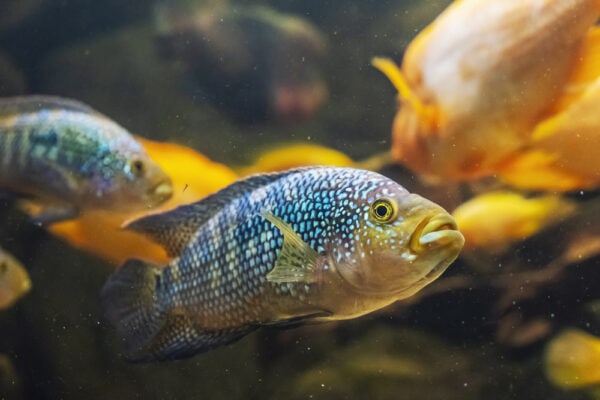
The Electric Blue Jack Dempsey has a giant head than their bodies. Their eyes are large and expressive. The primary color of their body is blue, but it may be interspersed with flashes of black, neon blue, light blue, and blue-white shades. Their mouth is rimmed with labial arches.
The fish has a dark brown background, black dotted body, with broken lines dotting them. The dorsal and anal fins of the Electric Blue Jack Dempsey are pretty significant.
There is a difference in the appearance of the males to the females. The male fish have deeper colors, and some have black spots on their tails or bodies. Most parts of their body look metallic and neon, as well. Males also have longer and pointy dorsal fins than females.
Younger fish have dull colors, which get better as they grow up. But, like most fish, if the adult fish are under duress, their colors will become soft and less shiny.
Adults grow up to 8 inches in size and generally live for 10 to 15 years.
Electric Blue Jack Dempsey – Features
Electric Blue Jack Dempsey has a life-long bond with their mate. This is a unique feature for fish, as most fish do not have a standing bond even after they have offspring. In this case, the Electric Blue Jack Dempsey stays loyal to their partners throughout their long life.
Another different feature is the level of difficulty in breeding them. Even though they are easy to care for, they are hard to reproduce. Most hobbyists try and fail at breeding a good number of young ones when it comes to this fish. Statistics show that only a quarter of the fry produced even survive adulthood. This fact, along with their recent discovery, makes them quite valuable. To pair a Jack Dempsey, you need to have a blue gene mate.
Also, their colors only show up after the fish have reached a length of at least 6 millimeters.
While breeding, we recommend keeping the dazzling blue ones separate from the duller blue ones – otherwise, the darker shade fry will gobble up the weaker ones.
If their offspring are threatened, they turn aggressive. Otherwise, they are meek and would rather hide in the sand than face another fish to pick a fight.
An important feature of an Electric Blue Jack Dempsey is recognizing its owners over time. As a result, they are keenly aware of their owners’ presence. This tells us that they are intelligent and aware of their surroundings.
Electric Blue Jack Dempsey – Aquarium Conditions
Electric Blue Jack Dempseys thrive in well-maintained tanks with specific conditions: a pH level between 6.5 and 7.0, water temperatures of 78 to 82°F, and ample hiding places to reduce stress. Regular water changes and monitoring are crucial for their well-being.
Like all tropical fish, the Electric Blue Jack Dempsey is picky about its environment. To make them feel comfortable in the tank, so that they may live and breed, you will need to replicate its marshy habitat. They feel most at home with a sandy substrate deep enough to burrow and dig into.
The minimum tank size that you can house an Electric Blue Jack Dempsey is 50 to 55 gallons. If you plan to keep an entire community of fish with the Jack Dempsey, we recommend that you go in for a bigger size. They are not that large, but the fish will need plenty of space to explore and lay claim to so that they do not pick fights with their tankmates. An ornamental invertebrate you keep in your tank will be eaten.
The Electric Blue Jack Dempsey is pretty hardy as far as tank conditions go. It can survive fluctuations, but ensure that it does not have to. Like all tropical fish, this fish prefers warmer waters and shady substrate to feel at home. The best substrate you can choose is sand, as Jack Dempsey likes to burrow and dig up leftover food from the substrate. They are big explorers and are curious about the bottom of your tanks. Give them a fine sand substrate, a lot of nooks and crannies to hide into, and a lot of plants and vegetation. You can place plants on the inside perimeter so that they have more space to swim and explore.
An Electric Jack Dempsey is notorious for plants and will try to uproot them all. You should get hardy plants (Sagittaria, Echinodorus, Elodie, Hornwort, for instance). You can pot your plants to avoid their roots from destruction.
The fish needs normal to moderate light. They are not comfortable in direct sunlight and will stay hidden if there is a lot of sunlight. Try to keep them in a semi-shaded area where your regular light reaches.
Their water requirements are diverse. An adult Electric Blue Jack Dempsey needs around 150 liters of water. If your fish is vast, your water level needs to go up. The water temperature needs to be between 72 to 86 degrees F (or 22.2 to 30 degrees C). When the pair is breeding, or placed in a separate breeding tank, keep a constant temperature of 86 degrees F. If you live in a colder place, invest in a heater. Your fish will die instantly if the temperature drops below the specified range.
The water movement requirement for them is medium. Get a pump if you feel like your tank needs a push for regulating the water movement. The fish prefer slightly salty water with a hardness range of 8 to 12 dGH. The pH of the tank has to stay between 6.5 to 8.
You need to cycle your tank before introducing a mating pair into the breeding tank. Otherwise, perform water changes once a week by replacing one-third of the water in the tank.
Electric Blue Jack Dempsey will need plenty of hiding spots, so be sure to include some large stones, small caves, snags, etc., to keep them entertained.
Electric Blue Dempsey – Food
Dempseys are perpetually hungry fish. Their diet is mainly a mix of carnivorous and omnivorous and consists of live and frozen food and plant and animal feed. They will eat all types of fresh food, pellets, meat, and smaller fish. So get some high-quality dry, frozen, and meaty food. You can also put in some vegetables. They prefer bloodworms, shrimps, and small fish more.
Ensure that you keep mixing their diet up to get all nutrients. The feeding frequency for these fish is four times a day.
Electric Blue Jack Dempsey – Breeding
Even though breeding an Electric Blue Jack Dempsey pair is very hard, if you are willing to give it a shot, then this is how it happens.
Before the mating pair is ready to breed, you will notice the adult male and female signs. In males, their copulative organs become more prominent and more noticeable. You should cycle a separate tank and add the pair into the tank. Keep a constant tank temperature, as mentioned above, of 86 degrees F. Ensure that the tank water is fresh, and replace the water every three days for high breeding chances.
During the spawning process, the female will lay the eggs around the tank’s decor, such as plants, stones, hiding spots, etc. The highest number of eggs that the female might lay during the entire period will be under a thousand or two thousand. You will notice that the fish become pretty aggressive during this time and protect their eggs severely. This is the main reason that you should consider a separate breeding tank.
Fry will hatch from the eggs after 2 or 3 weeks. At birth, they have faded, dull colors. The coloration will improve when the young ones reach the age of two months or so. During this time, the fry is susceptible to infections, diseases, and deadly disorders. To make sure that they stay healthy, raise the temperature by 2 to 3 degrees F. After 3 to 4 weeks have passed, you can reduce the temperature again.
Once the fry has gone older, you can introduce them to the main tank or let them have their tank.
Top 9 Electric Blue Jack Dempsey Tankmates
The Electric Blue Jack Dempsey is a tricky fish to introduce to a community tank. They might not have a quick temper like their parent family, Jack Dempseys, does. But, they can still prove harmful for other fishes in the tank. Only a few selective fish can coexist with the Electric Blue Jack Dempseys. Let us take a look at these fishes and their basic requirements.
1. Firemouth Cichlids
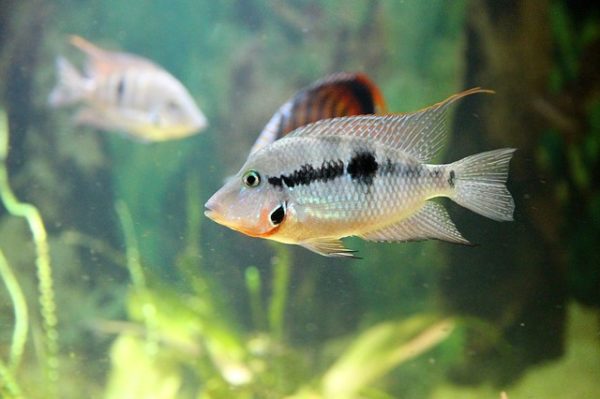
Firemouth cichlids have a self-explanatory name. Their mouth appears to have a band of fire gleaming around it.
This fish species is native to Central America. They are a little picky about their surroundings, but they will behave well as long as you meet their demands. Their demands entail plenty of space, hiding spots, and timely food. These fish are schooling fish bent on marking and guarding their territories. Firemouth Cichlids get easily stressed and might behave erratically.
Just like the Electric Blue Jack Dempsey fish, they get over-protective of their fry during the mating season and will guard them with their lives. However, they are always digging and exploring around and make for an excellent visual appeal to the tank.
- Care Level: Easy
- Tank Size: 30 gallons
- Temperament: Semi-aggressive
- Size: between 5 to 6 inches
2. Acara Cichlids
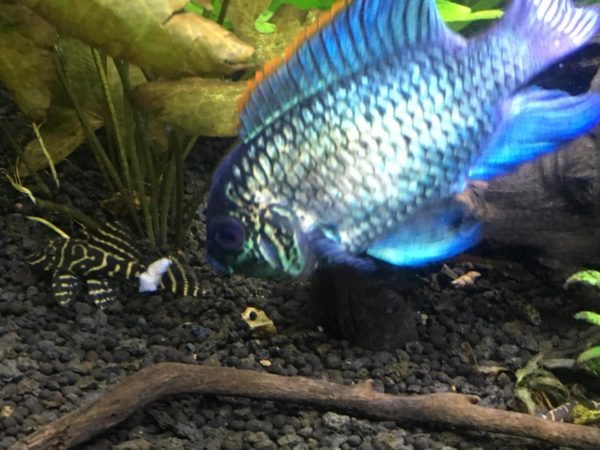
Acara Cichlids are yet another Cichlid variety that will do well with your Jack Dempsey Tank. Native to Central and South America, acaras are broadly divided into two species. True acaras are more extensive and grow long (up to 12 inches), and the other acaras grow up to 6 inches. Even though acaras love peaceful existence, they will stand their ground and show their aggressive side if they are threatened.
Acaras are also fond of eating smaller fish, so avoid housing them with small, timid fish in community tanks.
- Care Level: Easy
- Tank Size: 30 gallons
- Temperament: Semi-aggressive
- Size: between 5 to 6 inches
3. Convict Cichlids
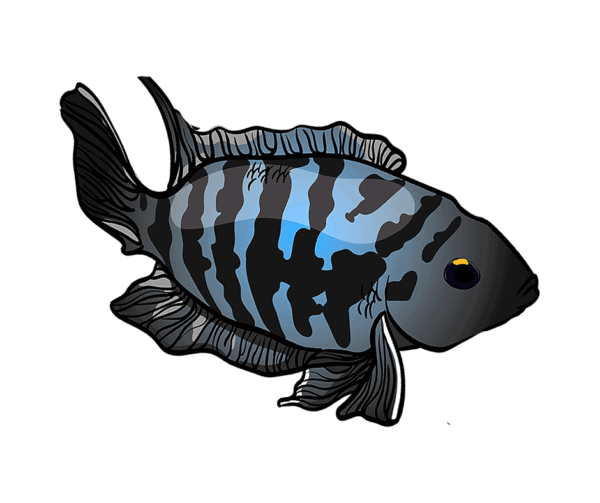
Convict Cichlids are called that because of their striped appearance and are famous for their aggressiveness. Labeled as the moodiest fish, these fish are easily triggered and get very competitive and possessive. However, just like the Jack Dempseys, they need their own space, a lot of hiding areas, and are playful.
Convict Cichlids are native to Central America in Guatemala, El Salvador, etc. Due to their nature and the extensive care they require, they are an expert-level fish to care for.
- Care Level: Hard
- Tank Size: 30 gallons
- Temperament: Aggressive
- Size: between 4 to 5 inches
4. Jewel Cichlids
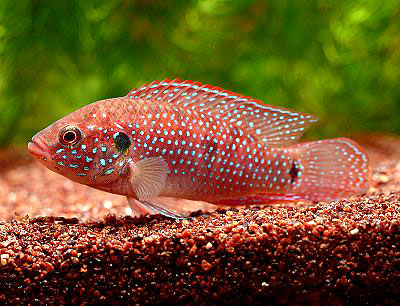
The Jewel Cichlid is a popular cichlid variety and is from Africa. These fish are colorful, and some even sparkle. They have colors such as red, blue, purple. The red or the orange variant of the Jewel Cichlid is more widespread.
The lifetime of a Jewel Cichlid is up to 5 or 6 years. They can grow up to 12 inches. Stocking the Jewel Cichlid in the community tank is a little tricky. They are often territorial and tend to be very aggressive, especially when the female lays the eggs and when caring for their fry. Of course, this does not mean you cannot stock them with other fish. They can. But one must ensure the tank is large enough to give room for the cichlid to form their territory.
- Care Level: Easy to medium
- Tank Size: 40 gallons
- Temperament: Aggressive
- Size: between 3- 12 inches
5. Gourami fish
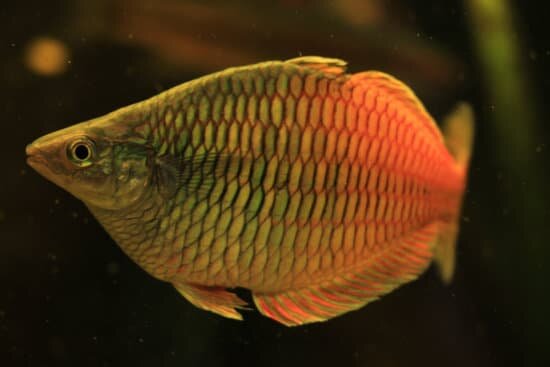
The Gourami ranks out of the top ten list of most colorful freshwater fish. Initially found in Asia, India, Korea, and Pakistan, many color variations are available. The Banded Gourami, the Blue Gourami, and the Red Fire Dwarf Gourami are more colorful species.
It is not uncommon to find great color palettes like gold, neon, blue, and even sunset. In addition, the Gourami is known to be quite active, playfully entertaining, and relatively easy to care for. They are also renowned for low maintenance, giving you one less thing to worry about.
- Care Level: Easy to medium
- Tank Size: 20 gallons
- Temperament: Peaceful
- Size: between 2- 28 inches
6. Severum Cichlids
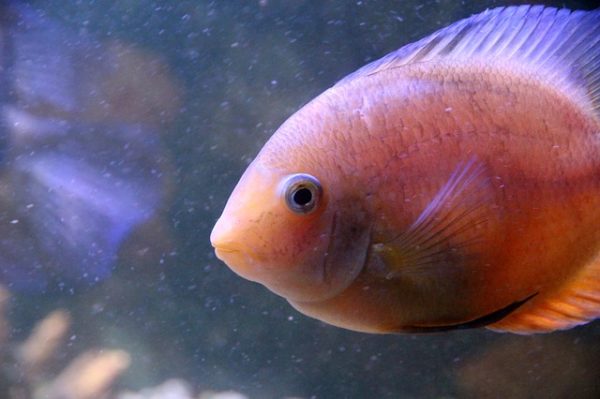
Severums are a species of the Cichlidae family. Their other names include banded cichlid, gold severum cichlid, etc.
Severum Cichlid hails from South America. They make for the perfect, neutral tankmates. They are neither timid nor aggressive but mind their own business. If they are kept in a tank with similarly-sized fish, they can coexist well. The Electric Blue Jack Dempseys are similar to the Severum cichlid in size and temperament. Just like the other Cichlids, these might try to eat the smaller fish in the tank, so be careful of that.
- Care Level: Easy to medium
- Tank Size: 45 gallons
- Temperament: Peaceful, sometimes semi-aggressive
- Size: between 8 inches
7. Rainbowfish
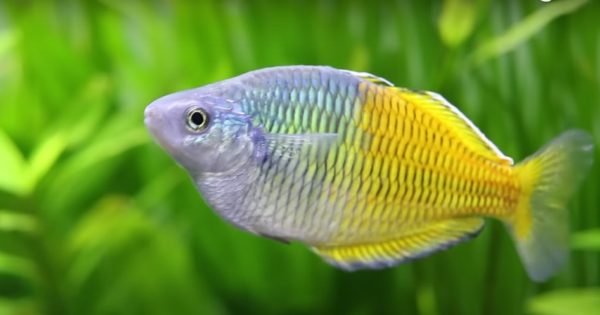
Rainbowfish, a species of freshwater fish, enjoys popularity in the aquarium industry. This is due to their vibrant rainbow-colored hues, as their name suggests. Even though their name sounds fun, any experienced hobbyist will tell you that these fish are a handful. They are good tank mates for the Electric Blue Jack Dempsey tank but are equally aggressive and territorial. The males are more inclined to pick fights and bully other tank mates. The best way to avoid any internal conflicts is to let them be in their own spaces. Once they have enough space, they can become some of the most peaceful tankmates to have.
- Care Level: Easy to medium
- Tank Size: 30 gallons
- Temperament: Peaceful
- Size: between 1 to 5 inches
8. Angelfish
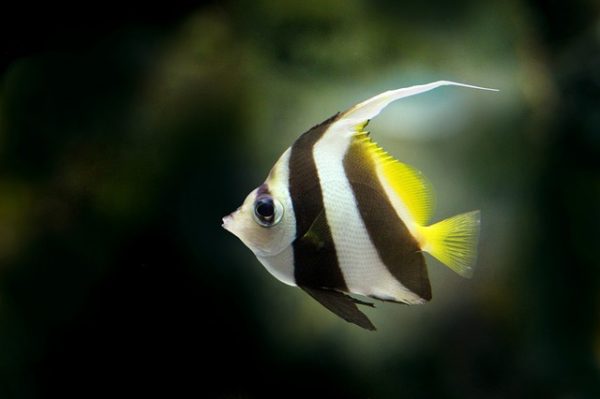
Pterophyllum Scalare, or freshwater angelfish, is a cichlid species native to South America. You can find these in places such as Colombia, Guyana, French Guiana, Peru, and Brazil, including the Rio Oyapock, Rio Essequibo, and Amazon.
Like most cichlids, they have a laterally compressed body structure, which essentially means they are pretty thin. Solid silver, multicolor stripes, and black-and-silver marble are among the hues and patterns available for these fish. They have various sub-species such as the Zebra Angelfish, Veil Angelfish, Albino Angelfish, Ghost Angelfish, etc.
- Care Level: Moderately easy
- Tank size: 29 gallons
- Temperament: Peaceful
- Size: 6 inches
9. Giant Danios
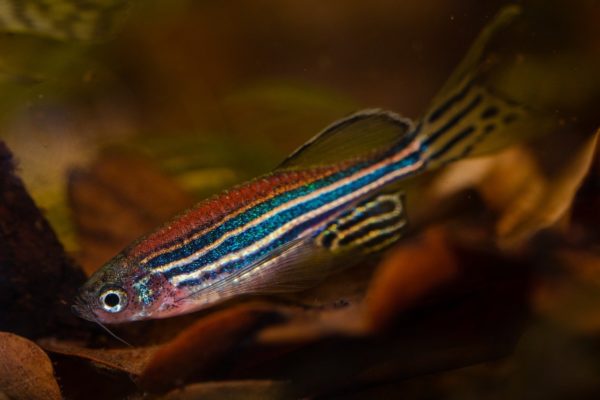
Giant Danios, also known as Golden Giant Danio, are easy to care for and great tank mates for larger fish species like the Dempsey. They are very active as a fish species and constantly swim around. Giant Danios are a mid and top dwelling fish originating from India, Nepal, Thailand, Myanmar, and Bangladesh.
Giant Danios have a semi-aggressive temperament because they often get riled up and harass smaller fish. However, they do not do well with equally aggressive tank mates, so keeping them with other semi-aggressive fish is their best chance at coexisting.
- Care Level: Moderately easy
- Tank size: 30 gallons
- Temperament: Semi-aggressive
- Size: 4 to 6 inches
How to Choose Tank Mates for Electric Blue Jack Dempsey?
Electric Blue Jack Dempsey is not an option for a community fish because of its temper. These fish are territorial and aggressive – more so when a pair is mated – and hence you cannot keep them with other fish. Compared to their parents, the Jack Dempsey, the Electric Blue Jack Dempsey is calmer. It is more tolerable of its tankmates.
During the time they are breeding, they become overly possessive. So we advise you to keep a mating pair in a tank either just or keep them in large groups in a larger tank but paired – so that there are no fights between males.
Try to stick to the fish we have outlined for your reference above, as they have been proven to coexist with the Electric Blue Jack Dempsey peacefully.
Conclusion
The Electric Blue Jack Dempsey is a hardy fish with a winning personality. The gorgeous electric blue color and the black spots like marble make it look stunning. You can easily house this species as a centerpiece in your home aquarium because of their appearance and ease of care. If you pick and choose the correct tank mates, it will thrive and merge itself into a community well. Just make sure to give it enough space to keep its temper in check! We hope that this guide can guide you through the dos and don’ts of keeping an Electric Blue Jack Dempsey pair.

